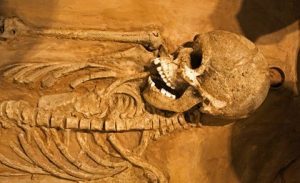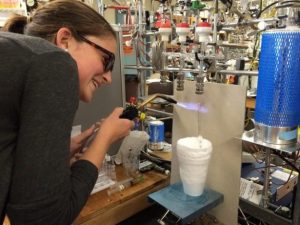Latest News
 Four thousand years ago, the Harappan civilization thrived in what is now modern-day Pakistan. By 1800 BC their cities were abandoned. Now a team of scientists think they have discovered where they went.
Four thousand years ago, the Harappan civilization thrived in what is now modern-day Pakistan. By 1800 BC their cities were abandoned. Now a team of scientists think they have discovered where they went.
This video highlights the work of WHOI scientist Liviu Giosan and some members of NOSAMS (where his samples were analyzed).
Who is WHOI? is a short video highlighting different scientists and answering what it means to work for WHOI. Look for NOSAMS staff throughout the film: 00:56 Kalina Gospodinova, 00:59 Josh Burton and Brett Longworth, 01:07 Josh Burton, 03:27 Josh Burton, 04:05 Anne Cruz.
Please follow the latest news and updates from our lab on Twitter: @NOSAMSLab
 Frenkel is the lead author on a paper recently published in the journal Deep Sea Research I. Research for her paper, “Quantifying bamboo coral growth rate nonlinearity with the radiocarbon bomb spike: A new model for paleoceanographic chronology development,” was done with the help of co-author Hannah Miller ’17; LaVigne served as senior author. Also involved in the project were colleagues Tessa Hill at UC Davis, and Ann McNichol and Mary Lardie Gaylord at the National Ocean Sciences Accelerator Mass Spectrometry facility (NOSAMS) at Woods Hole. LaVigne said Frenkel successfully used radiocarbon dating techniques to reconstruct how corals grow, “and she found out that the growth rates of these corals slow down as they get larger. Previously it had been thought they grew at a constant rate. This is a critical finding for paleoceanographers who use these corals as climate archives,” she continued, “as it allows us to interpret our climate records with a more precise timescale. And because this advances our understanding of how bamboo corals grow, it helps us measure how quickly deep sea coral habitats might recover from damage.” Learn more at…
Frenkel is the lead author on a paper recently published in the journal Deep Sea Research I. Research for her paper, “Quantifying bamboo coral growth rate nonlinearity with the radiocarbon bomb spike: A new model for paleoceanographic chronology development,” was done with the help of co-author Hannah Miller ’17; LaVigne served as senior author. Also involved in the project were colleagues Tessa Hill at UC Davis, and Ann McNichol and Mary Lardie Gaylord at the National Ocean Sciences Accelerator Mass Spectrometry facility (NOSAMS) at Woods Hole. LaVigne said Frenkel successfully used radiocarbon dating techniques to reconstruct how corals grow, “and she found out that the growth rates of these corals slow down as they get larger. Previously it had been thought they grew at a constant rate. This is a critical finding for paleoceanographers who use these corals as climate archives,” she continued, “as it allows us to interpret our climate records with a more precise timescale. And because this advances our understanding of how bamboo corals grow, it helps us measure how quickly deep sea coral habitats might recover from damage.” Learn more at…
Dear Friends of NOSAMS,
I am writing to give you a brief NOSAMS news update. First, we have not raised rates for 2017, which means that sample fees have remained constant for the past four years. We are presently returning results in less than one month, so this is an excellent time to submit your 14C samples. One important change to our fee structure is that we are now able to offer the lower (NSF subsidized) rates to both U.S. Federally-funded and U.S. Academic Research, i.e., to include University-funded research programs such as start-ups and student/seed projects. The NOSAMS’ website has information on services, fees, submission and processing of samples (https://www.whoi.edu/nosams). The attached one-page brochure provides details as well. Please let us know if you have any suggestions regarding the services we provide, or anything that will improve NOSAMS’ service to the community.
During the summer of 2016, we installed a 134 sample gas-hybrid ion-source on the tandetron AMS system, which provides greater capacity and capability.
NOSAMS will once again offer two graduate student internships this year. So if you know of a worthy graduate student project be sure to point them to NOSAMS; the deadline for applications is June 1, 2017. An internship can include free 14C analyses and an opportunity to visit NOSAMS and learn about radiocarbon AMS first-hand.
Karl von Reden, Associate Director and Staff Physicist, formally retired July, 2016, after more than 27 years of service! We are grateful for all that he has done, and also that we still see him on a regular basis.
We note with great sorrow the passing of our dear friend, colleague, and Director Emeritus, John Hayes on February 3, 2017. He will be sorely missed; a link to the full obituary can be found at https://www.whoi.edu/obit/john-hayes.
We look forward to working with you and welcome the opportunity to help with your radiocarbon needs. Please don’t hesitate to contact me or anyone else here at NOSAMS.
Best regards,
Mark Kurz for NOSAMS

Dear Friends of NOSAMS,
-I am writing to let you know that we have not raised our rates for 2016, which means that our sample fees have remained constant for the last three years. In addition, our turnaround-time is presently below one month, an all-time low, so this is an excellent time to submit your 14C samples.
The NOSAMS website has details of services we provide (https://www.whoi.edu/nosams), and the attached one-page brochure provides details as well. We enjoyed seeing many of you who visited our exhibitor booth at the 2015 AGU Fall meeting. We got great feedback and, for those who did not attend, please feel free to contact us with any of your sample processing needs. Also, let us know if you have any feedback regarding the services we provide and anything else that will improve NOSAMS’ service to the community.
NOSAMS will once again offer two graduate internships this year, so if you know of a worthy graduate student project be sure to point them to NOSAMS; the deadline for applications is June 1, 2016. An internship can include free 14C analyses and an opportunity to visit NOSAMS and learn about radiocarbon AMS first-hand. Also, there are plans to have a workshop on Ramped Pyrolysis for radiocarbon measurements here in Woods Hole, tentatively scheduled for September 2016 (contact: Ann McNichol, amcnichol@whoi.edu).
Finally, let me state what an honor it is to be part of the fantastic NOSAMS team. I look forward to working with you and welcome the opportunity to help with your radiocarbon needs. Please don’t hesitate to contact me or anyone else here at NOSAMS.
Best regards,
Mark Kurz for NOSAMS
mkurz@whoi.edu
 Dr. Kyle Van Houtan turns to an unlikely environmental marker to better understand the life of the world’s seven marine turtle species, all but one of which are endangered. Read more…
Dr. Kyle Van Houtan turns to an unlikely environmental marker to better understand the life of the world’s seven marine turtle species, all but one of which are endangered. Read more…
Dr. Paul Aharon and Dr. Steven Jacobs use radiocarbon dating to investigate how old a Torah rescued from the Nazis in the Czech regions of Bohemia and Moravia might be.
 Harvard University professor Karen L. King with Noreen Tuross investigate a a tiny fragment of ancient Egyptian papyrus whose eight partial lines of Coptic script included one sensational half-sentence: “Jesus said to them, ‘My wife . . .’ ”
Harvard University professor Karen L. King with Noreen Tuross investigate a a tiny fragment of ancient Egyptian papyrus whose eight partial lines of Coptic script included one sensational half-sentence: “Jesus said to them, ‘My wife . . .’ ”
 MIT/WHOI joint program student Jordan Hemingway unlocks clues to how our planet works by studying rivers.
MIT/WHOI joint program student Jordan Hemingway unlocks clues to how our planet works by studying rivers.
